
Concept explainers
Answer the following questions about

a. What starting materials are needed to form
b. What starting materials are needed to form
c. What product is f ormed when
d. Draw the Robinson annulation product(s) formed by reaction of
e. Draw the structure of the most stable enol tautomer(s).
(a)
Interpretation: The starting materials needed to form
Concept introduction: In crossed Claisen condensation reaction, a base abstracts an acidic proton from an
Answer to Problem 24.65P
The starting materials needed to form
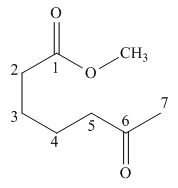
Figure 1
Explanation of Solution
The given compound is,
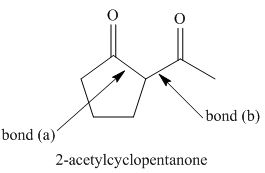
Figure 2
The starting materials needed to form

Figure 1
The base abstracts the proton from
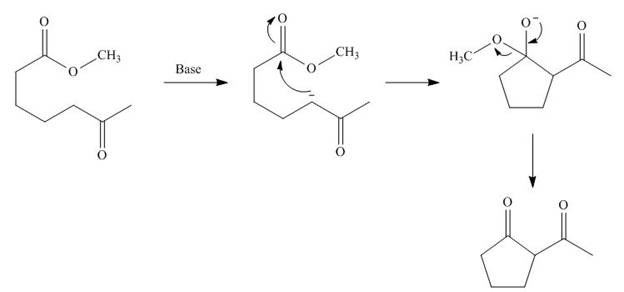
Figure 3
The starting materials needed to form
(b)
Interpretation: The starting materials needed to form
Concept introduction: In crossed Claisen condensation reaction, a base abstracts an acidic proton from an
Answer to Problem 24.65P
The starting materials needed to form
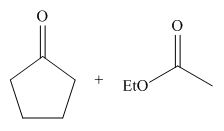
Figure 4
Explanation of Solution
The given compound is,

Figure 2
The starting materials needed to form

Figure 4
The base abstracts the proton from

Figure 5
The starting materials needed to form
(c)
Interpretation: The product formed on treatment of
Concept introduction: Alkylation of carbonyl compounds takes place in the presence of a strong base. The use of appropriate base, solvent and temperature can yield one major product regioselectively. The first step is abstraction of proton and second step is attack of electrophile to form alkylated product.
Answer to Problem 24.65P
The product formed on treatment of

Figure 6
Explanation of Solution
The product formed on treatment of

Figure 7
The base
The product formed on treatment of
(d)
Interpretation: The products formed on Robinson annulations of
Concept introduction: Robinson annulation is a combination of Michael addition and intramolecular aldol condensation reactions. It takes place between
Answer to Problem 24.65P
The products formed on Robinson annulations of

Figure 8
Explanation of Solution
The first step is the Michael addition between
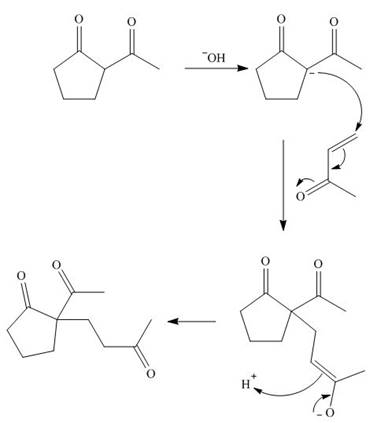
Figure 9
The base abstracts the proton between the two carbonyl groups to form enolate. The enolate formed gives the conjugate addition on methyl vinyl ketone followed by protonation resulting in
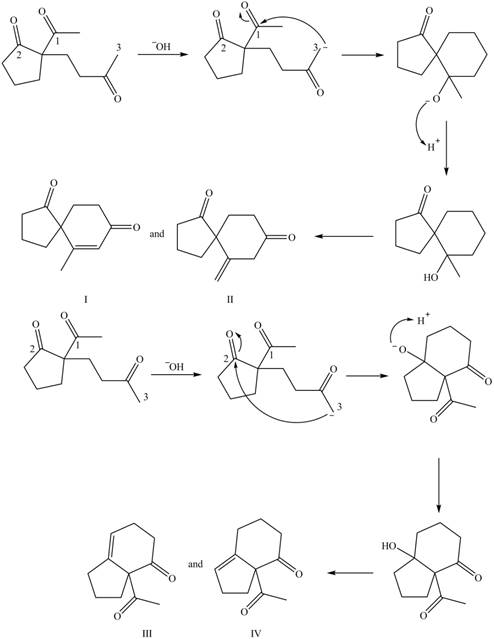
Figure 10
The base abstracts the acidic proton from the
The products formed on Robinson annulations of
(e)
Interpretation: The structure of the most stable enol form tautomer is to be drawn.
Concept introduction: Keto and enol form of a compound exists in the chemical equilibrium with each other. Enol form refers to the compound in which carbonyl group exist as hydroxyl group adjacent to carbon-carbon double bond.
Answer to Problem 24.65P
The structure of the most stable enol form tautomer is,
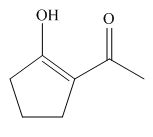
Figure 11
Explanation of Solution
The enol form tautomer of
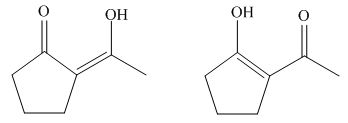
Figure 12
The stability of enols depends on the stability of alkenes. The alkene with endo double bond is more stable in case of five membered ring.
Thus, the most stable enol form tautomer is,

Figure 11
The structure of the most stable enol form tautomer is shown in Figure 11.
Want to see more full solutions like this?
Chapter 24 Solutions
ORGANIC CHEMISTRY
- Calculating standard reaction free energy from standard reduction... Using standard reduction potentials from the ALEKS Data tab, calculate the standard reaction free energy AG° for the following redox reaction. Be sure your answer has the correct number of significant digits. 3+ H2(g)+2OH¯ (aq) + 2Fe³+ (aq) → 2H₂O (1)+2Fe²+ (aq) 0 kJ x10 Х ? olo 18 Ararrow_forwardCalculating the pH of a weak base titrated with a strong acid An analytical chemist is titrating 184.2 mL of a 0.7800M solution of dimethylamine ((CH3) NH with a 0.3000M solution of HClO4. The pK₁ of dimethylamine is 3.27. Calculate the pH of the base solution after the chemist has added 424.1 mL of the HClO solution to it. 2 4 Note for advanced students: you may assume the final volume equals the initial volume of the solution plus the volume of HClO 4 solution added. Round your answer to 2 decimal places. pH = ☐ ☑ ? 000 18 Ar 1 Barrow_forwardUsing the Nernst equation to calculate nonstandard cell voltage A galvanic cell at a temperature of 25.0 °C is powered by the following redox reaction: MnO2 (s)+4H* (aq)+2Cr²+ (aq) → Mn²+ (aq)+2H₂O (1)+2Cr³+ (aq) + 2+ 2+ 3+ Suppose the cell is prepared with 7.44 M H* and 0.485 M Cr²+ in one half-cell and 7.92 M Mn² and 3.73 M Cr³+ in the other. Calculate the cell voltage under these conditions. Round your answer to 3 significant digits. ☐ x10 μ Х 5 ? 000 日。arrow_forward
- Calculating standard reaction free energy from standard reduction... Using standard reduction potentials from the ALEKS Data tab, calculate the standard reaction free energy AG° for the following redox reaction. Be sure your answer has the correct number of significant digits. NO (g) +H₂O (1) + Cu²+ (aq) → HNO₂ (aq) +H* (aq)+Cu* (aq) kJ - ☐ x10 x10 olo 18 Ararrow_forwardCalculating the pH of a weak base titrated with a strong acid b An analytical chemist is titrating 116.9 mL of a 0.7700M solution of aniline (C6H5NH2) with a 0.5300M solution of HNO3. The pK of aniline is 9.37. Calculate the pH of the base solution after the chemist has added 184.2 mL of the HNO 3 solution to it. Note for advanced students: you may assume the final volume equals the initial volume of the solution plus the volume of HNO3 solution added. Round your answer to 2 decimal places. pH = ☐ ☑ 5arrow_forwardQUESTION: Find the standard deviation for the 4 different groups 5.298 3.977 223.4 148.7 5.38 4.24 353.7 278.2 5.033 4.044 334.6 268.7 4.706 3.621 305.6 234.4 4.816 3.728 340.0 262.7 4.828 4.496 304.3 283.2 4.993 3.865 244.7 143.6 STDEV = STDEV = STDEV = STDEV =arrow_forward
- QUESTION: Fill in the answers in the empty green boxes regarding 'Question 5: Calculating standard error of regression' *The images of the data showing 'coefficients for the standard curve' have been providedarrow_forwardUsing the Nernst equation to calculate nonstandard cell voltage Try Again Your answer is wrong. In addition to checking your math, check that you used the right data and DID NOT round any intermediate calculations. A galvanic cell at a temperature of 25.0 °C is powered by the following redox reaction: 2+ 2+ Sn²+ Ba(s) (aq) + Ba (s) Sn (s) + Ba²+ (aq) →>> Suppose the cell is prepared with 6.10 M Sn 2+ 2+ in one half-cell and 6.62 M Ba in the other. Calculate the cell voltage under these conditions. Round your answer to 3 significant digits. 1.71 V ☐ x10 ☑ 5 0/5 ? 00. 18 Ararrow_forwardQuestion: Find both the b (gradient) and a (y-intercept) value from the list of data below: (x1 -x̄) 370.5 (y1 - ȳ) 5.240 (x2 - x̄) 142.5 (y2 - ȳ) 2.004 (x3 - x̄) 28.5 (y3 - ȳ) 0.390 (x4 - x̄) -85.5 (y4 - ȳ) -1.231 (x5 - x̄) -199.5 (y5 - ȳ) -2.829 (x6 - x̄) -256.5 (y6 - ȳ) -3.575arrow_forward
- Calculating standard reaction free energy from standard reduction... Using standard reduction potentials from the ALEKS Data tab, calculate the standard reaction free energy AG° for the following redox reaction. Be sure your answer has the correct number of significant digits. 3Cu+ (aq) + Cro²¯ (aq) +4H₂O (1) → 3Cu²+ (aq) +Cr(OH)3 (s)+5OH˜¯ (aq) 0 kJ ☐ x10 00. 18 Ararrow_forwardCalculating the pH of a weak base titrated with a strong acid An analytical chemist is titrating 241.7 mL of a 0.4900M solution of methylamine (CH3NH2) with a 0.7800M solution of HNO3. The pK of methylamine is 3.36. Calculate the pH of the base solution after the chemist has added 17.7 mL of the HNO3 solution to it. Note for advanced students: you may assume the final volume equals the initial volume of the solution plus the volume of HNO3 solution added. Round your answer to 2 decimal places. pH = ☑ ? 18 Ararrow_forwardThe following is two groups (Regular tomato sauce & Salt Reduced Tomato Sauce) of data recorded by a team analysising salt content in tomato sauce using the MOHR titration method: Regular Tomato Sauce Salt Reduced Tomato Sauce 223.4 148.7 353.7 278.2 334.6 268.7 305.6 234.4 340.0 262.7 304.3 283.2 244.7 143.6 QUESTION: For both groups of data calculate the answers attached in the image.arrow_forward
 Chemistry for Today: General, Organic, and Bioche...ChemistryISBN:9781305960060Author:Spencer L. Seager, Michael R. Slabaugh, Maren S. HansenPublisher:Cengage Learning
Chemistry for Today: General, Organic, and Bioche...ChemistryISBN:9781305960060Author:Spencer L. Seager, Michael R. Slabaugh, Maren S. HansenPublisher:Cengage Learning
